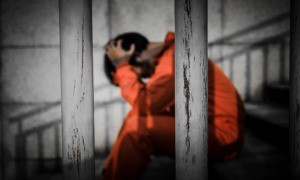 The numbers tell us two sobering facts about girls and juvenile justice. First, they tell us that the percentage of girls in the juvenile justice system has steadily increased over the decades, rising from 17 percent in 1980 to 29 percent in 2011. Second, girls are more likely than boys to be arrested for “status offenses” — behaviors that would not be considered offenses at the age of majority — and often receive more severe punishment than boys.
The numbers tell us two sobering facts about girls and juvenile justice. First, they tell us that the percentage of girls in the juvenile justice system has steadily increased over the decades, rising from 17 percent in 1980 to 29 percent in 2011. Second, girls are more likely than boys to be arrested for “status offenses” — behaviors that would not be considered offenses at the age of majority — and often receive more severe punishment than boys.
According to the Coalition for Juvenile Justice’s issue brief, Girls, Status Offenses and The Need For A Less Punitive and More Empowering Approach, a disproportionate number of the status offenses petitioned in the courts every year are brought against girls. Between 1995 and 2009, the number of petitioned cases for curfew violations for girls grew by 23 percent vs. only 1 percent for boys. The number of petitioned cases for liquor law violations for girls grew by 41 percent vs. only 6 percent for boys.
Simply put, behaviors such as skipping school, running away, breaking curfew and possession or use of alcohol places girls at increased risk of entering the juvenile justice system. Girls entering the system because they are detained for a status offense often fall deeper into the system rather than getting the support they need to change their lives.
What the numbers fail to reveal is the story behind the statistics. As the president of The National Crittenton Foundation, I have had the great privilege to get to know many of the faces behind the data — girls and young women who were involved with Crittenton agencies because they were referred by juvenile justice or child welfare systems. While their stories are as diverse as they are, the most common shared narrative for the girls served by Crittenton agencies is that their early lives have been shaped for them by abuse, neglect, violence, addiction, family dysfunction and the betrayal of their trust by the very people whose job it was to love and protect them.
Victimization of girls typically precedes their involvement with the system. Up to 73 percent of the girls in the juvenile justice system have histories of physical and sexual violence. A study of 319 girls in the juvenile justice system in Florida found that 64 percent reported past abuse, including 37 percent reporting abuse by a parent; 55 percent reporting abuse by someone other than a parent; and 27 percent reporting both types of abuse.
Data collected by The National Crittenton Foundation in 2011 further illustrates the extent of the trauma experienced by girls in the juvenile justice system. Our agencies administered the Adverse Childhood Experiences (ACE) questionnaire to 200 girls in or referred by the juvenile justice system in 18 states. We found that more than 62 percent of juvenile justice involved girls and 74 percent of young mothers surveyed were exposed to four or more forms of adverse childhood experiences, which include exposure to violence. In comparison, the national ACE/CDC study results found that 15 percent of women surveyed had scores of four or more.
What the statistics also don’t tell us is how girls cope with the dangerous, damaging and traumatic circumstances in their lives. In fact, their “adaptive coping behaviors,” including running away from homes where violence is prevalent, self medication with drugs and alcohol, truancy and unruly behavior, are the very same behaviors that put them at risk of entering the juvenile justice system because they are detained for a status offence. In other words, we criminalize them for coping behaviors that are actually signs of strength and resiliency against the abuse and neglect they have experienced. What is the result? A system that fails to help the girls get the help they need to recover from the abuse and neglect they experienced long before they entered the system.
Deeply embedded in our response to these girls, and absent from the policy discussions about solutions, is the underlying presence of age-old social gender role expectations. Girls should be “sugar and spice and everything nice.” Good girls are chaste, virtuous and pure, respectful and demur, seen and not heard. The consequence for not meeting those gender role expectations is to be labeled for life — “A bad girl.” We detain them for status offenses as a means of holding them accountable for not living up to the standards set for “good girls.”
I’ve learned a lot from young women and women who have come through the system. They have taught me about the power and the weight of the “bad girl” image, which keeps them mired in shame and leads to isolation from family connections and social networks. It stops them from asking for help or speaking the truth. It stops them from defending themselves and for letting their light shine. Why, because deep inside they are internalizing this image and something tells them it might be true. And the way that systems are organized reinforces that it is indeed true — once a bad girl always a bad girl.
In a society where the sexualization, commercialization and objectification of girls runs rampant in the media, entertainment industry, retail advertising its ironic that we still judge girls for their ability to be virtuous. The National Crittenton Foundation has been around for more than 130 years and in the late 1800’s we called them lost, depraved, wayward and fallen women. We don’t use the same words today but attitudes really haven’t change that much. As a society we need to value young women for their brains, their hearts and their will to build better lives for themselves.
So what is the solution? How can public policy responses strengthen the ability to get girls the help they need to heal from the trauma they have experienced as children? Taken together, the steps below would provide an excellent starting point to shift the conversation from how to deal with “bad girls” to one that recognizes the strength and resiliency of girls so they can get the support they need. These steps include:
-
Promote universal assessment for girls and boys involved in the juvenile justice system to better understand their exposure to violence, abuse and neglect.
-
Advocate that girls in or at risk of entering the juvenile justice system receive gender-responsive, trauma-informed services to heal from the violence and abuse they have experienced.
-
Push for the reauthorization of the Juvenile Justice Delinquency Prevention Act, with a focus on preventing detention for status offenses and the importance of gender responsive and trauma informed services
-
Support HR 4123, Prohibiting the Detention of Youth for Status Offenses Act, introduced recently by Representative Tony Cardenas (D-Calif.) and
-
Endorse and advance the important work of organizations like the Coalition for Juvenile Justice and the National Standards for the Care of Youth Charged with Status Offenses.
The reality is this is the “easy” stuff. Passing legislation and advancing standards only takes the stroke of a pen or changing the words in policy guidance. But in the end, negative attitudes and assumptions will undermine the best of intentions. The “bad girl” image will continue to thrive and fail to break destructive cycles of abuse and neglect.
So on behalf of the girls and young women who have shared their stories and helped me understand their reality, I challenge each and every one of us to take some time and think about whether we see girls and young women in the juvenile justice system as “bad girls.” Do we understand their behaviors as acting out and out of control or do we see their actions as a way of coping with experiences that are unthinkable to us? And if we begin to understand the actions of the girls as a call for help, what can we do with what we discover?
Jeannette Pai-Espinosa is the president of The National Crittenton Foundation. She brings to this 130-year-old institution more than 30 years of experience in advocacy, education, intercultural communication, public policy, strategic communication, program development and direct service delivery.



























